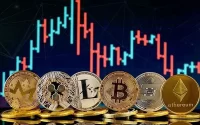What are Non-fungible tokens and how is it different from fungible tokens?
A non-fungible token is a token which is unique from the rest also this is the digital representation of scarce assets. Because it is a special type of cryptographic in short, it is not interchangeable by their individual specialization i.e. this currency is in contrast with other cryptocurrencies such as Zcash or other utility tokens that are fungible in nature. Non-Fungible tokens are used in several specific applications that require unique digital items like crypto art and crypto-gaming.

NFTs are much more impactful from the rest!
It is a more diverse asset class that could have more impactful uses than the other fungible tokens. Because fungible tokens were dominated in the early years of block gain networks. It is also known as nifty. The famous example of NFTs includes domain names, event tickets, and the ownership which records for physical assets.
Evolution and valuation of NFTs
The very first NFTs began in 2013 which was a color coin that was created upon the Bitcoin Network. After it made NFTs impression on the crypto world was the advent of ERC721. According to its features, it could track the movements and ownership patterns of the individual coins along with making it valuable and Non-fungible.
But, what are their unique features?
- A unique set of characteristics
- NFTs have unique ownership also they are not separable and not interchangeable by another matching NFT
- It signifies ownership and privileges
- The very fast application which was succeeded of ERC721 was CryptoKitties
- The NFTs most expensive trade was $172,625 in 2017.
There is one more industry that was significant for non-fungible tokens were the gaming industry. It made it easy because gamers have been already well acquainted with digital collectibles.
According to sources in the future – “To initiate the real-world transactions there will be linking of the physical assets with the NFTs such as Software Licenses”.
Since the use of fungible crypto has yielded the positive results in the digital asset ecosystem it’s establishing the importance. But, signify the potential of tokenizing physical assets, whereas holding on to its distinctive properties. It’s tested that it’ll not cause hindrance to the prevailing cryptocurrencies within the system, however rather the spectrum of Blockchain technology within the years to come back.
NFTs are unit distinctive in nature, with various properties that may be distinguished from one another such as CryptoKitties in 2017. It is a game on the Ethereum blockchain where players will collect and breed digital cats that they acquire in ETH, and wherever every cat’s digital “genetic material” is held on to the Ethereum blockchain. Providing and managing digital, unique, and so scarce assets like collectibles isn’t a brand new issue, however before the emergence of blockchain and different distributed ledgers, this sort of insufficiency was pricey to manage. It relied on the validation and security of the centralized provision entities. Distributed ledgers, on the opposite hand, alter a suburbanized and publicly verifiable substrate to issue and manage these assets at terribly low operational prices.
Distinctive designs
non-fungible tokens moreover alter the tokenization of every kind of asset, which was either real or digital. They permit distinctive investments tied to an object, like distinctive design, land, or the other real-world assets and securities. They conjointly permit halfway possession of products that weren’t simply cleavable before, like land, artwork, or different record. Tokenizing physical assets offers investors a lot of liquidity. One may tokenize a building, wherever some tokens may grant straightforward possession titles of a fraction of the important estate, whereas different tokens may grant special privileges like access rights. non-fungible tokens conjointly and potential use in digital art, by serving to prove rootage, credibleness, and possession.
- The construct of non-fungible crypto tokens isn’t new. In 2013, colored Coins was one among the primary comes that tried to tie distinctive properties to digital quality.
- The thought was to use Bitcoin tokens to represent real-world assets like stocks, bonds, commodities, or the deed for a house. Counterparty was another project that was designed on this concept however went one step more.
- It enabled users to form their virtual assets on top of the Bitcoin blockchain. Each came struggled to achieve wide adoption once Ethereum emerged, permitting a lot of straightforward token issues and sales with some lines of code. This spurred token sales as a brand new manner of fundraising vehicles.
The success of ERC-721 in all probability conjointly triggered different blockchain comes, like the modern blockchain, to start the event of their non-fungible token standards.
Some use cases
- Access and Asset Tokens
- Access Transfer Tokens
Exciting use cases for non‑fungible tokens (NFTs) area unit cropping up all the time — and they’re even being touted because of the way forward for the vice business, the art business, and even in some cases the important estate business!
NFTs also can command serious money, with some marketing for many dollars around in thousands.
But what area unit they? What will they be used for, however, do they work, and what area unit a number of the known comes within the business today?
It’s simple once you Know!
- Fungibility’ sounds difficult — however, it’s an extremely straightforward construct that relates to the items we tend to own and use each day. It applies to real-world assets also as digital ones.
- The dollar in your pocket — or the Bitcoin in your crypto pocketbook — may be a prime example of a fungible quality. each area unit simply replaced by one thing that’s (for all intents and purposes) identical.
- If ellen lends Juliet $10, he wouldn’t get to receive precisely the same paper currency back, as a result of they’re equally as valuable.
All of this changes with a non‑fungible quality. Let’s imagine Ellen lends Juliet his rare trading card. If she gave him back a standard card, he’d in all probability be very irritated. the 2 cards might look identical in form, size, texture, and so on… however the main points written on them build them distinctive.
Advantages:
The composition of a non-fungible token is what makes it completely different and of a lot of worth. The NFT mechanism involves the storage of made data. This transcends the standard puff properties like the image, name offer, and also the balance of the token. The NFT stores the possession and quality details also. Besides these, these house owners get rootage assurance, and this includes future patrons also.
What is the difference?
Bitcoin has a supply of around 21 million identical coins but NFTs are different.
Unique capabilities
- Fungibility interchanges the assets or goods with another.
- Non-Fungible can’t interchange the goods or assets like owned houses etc. Metadata makes a unique asset from the rest.
Cannot split
- NFTs are indivisible I.e. it can be sold or held the whole. In short, NFTs have there own rule that no one would collect 50% of a baseball card or can’t purchase 10% of a plane ticket.
Scarcity
- Scarcity is rare as well as the most important aspect in NFTs which makes this so much attractive. However, developers have the right to generate an infinite supply of certain assets along with these developers also have the freedom to limit the number of desirable items. While the fungibility has their own different rights.
Now, the question arises why should You invest in NFTs?
NFTs in the profitable sort of investment attributable to some subsequent reasons:
Tokenized Asset:
NFTs produce a medium whereby physical objects like artworks are often tokenized, therefore eliminating the duplication of such artwork and limiting possession to the creator. This creates a lack for artwork because it automatically increases.
It provides Investors additional Liquidity:
Tokenizing assets provides investors additional liquidity over their assets once they want it. In simple words, once a virtual landowner decides to lend his/her virtual area to advertisers or influencers and charges a fee whereas still possession over the land. The virtual land during this case still belongs to the owner, however a part of it’s liquified as rent.
Potential for growth and development:
Non-Fungible Tokens possess the potential for growth and development of the land sector. Pegging NFTs to land items has proved to have a high potential for growth and development, for example in the land, owning and dominant virtual lands provide you the facility to decide on what you wish to try and do on your land. you’ll be able to plan to rent it out, build up a solid and secure business for advertising or on-line sales.
According to some sources NFTs are close to crossing $100M because from 2017 their popularity has increased.
ERC-721 deals with two events
- Transfer
whenever a token’s ownership is changed or moved then this event is fired.
- Approval
whenever the ownership changes token I’d be checked.
There are other two non-fungible standards
- ERC-998
- ERC-1155


